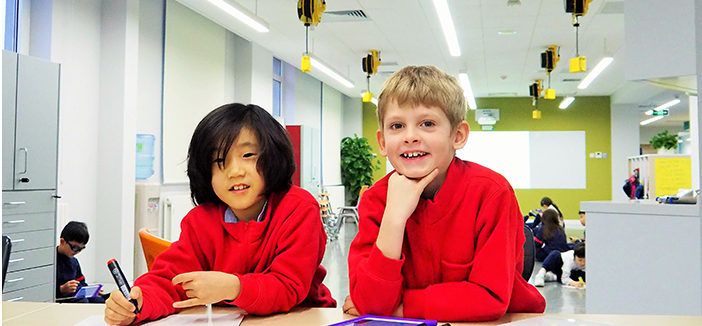Education has come a long way since the heydays of “chalk and talk”, when a teacher stood in front of rows of desks lecturing a room full of bored children. The concept of student-centered learning recognizes that we all learn at different paces and in different ways, and shifts the focus from the expert educator to the skilled learner.
As the 21st century takes shape this approach has become even more important. In the workplaces of the future, machines and computers will carry out all the mundane tasks, and the critical skills for career success will be creativity, collaboration, research, and self-reliance.
Now, Yew Chung International School of Beijing has taken the next step into that future and begun the process of doing away with traditional classrooms altogether. Early Childhood Education (ECE) (preschool) and Year 3 (grade 2) are already spending most of their day in a Learning Community, with Years 4 and 5 set to join them next year, as the next stage of the school’s ongoing evolution.
But what is a Learning Community?
In its broadest sense, it can mean any group of people coming together to learn. But YCIS Beijing’s Learning Community is also a space, designed to support student centered, collaborative teaching and learning.
“When you have classes of many students, every student is engaged in their own activities; students all learn in different ways,” says architect James Seaman of Fielding Nair International (FNI), who designed the Learning Community for YCIS Beijing. “It’s very important to provide a space that allows for those different activities to take place simultaneously. This kind of learning requires the ability for students to flow out into different areas; maybe one student is in a classroom, one is with a teacher, other students break out into a common area to work in groups with their peers or individually; what’s important is they’re in charge of how they learn best and the learning community allows them to find the appropriate space to do that.”
FNI are educational specialists, who have worked with prestigious schools across the globe, and Seaman is clear about the need for a new approach to meet the challenges our children will face in their careers.
“If you take a look at a traditional model,” he says, “it’s really just a carbon copy of the same kinds of spaces over and over: the same size of space lined along a corridor. With that kind of structure, you don’t really have a lot of variety; learners don’t have the opportunity to really engage in a lot of activities.
“With 21st century learning, different modes of learning are available: you have collaboration, traditional direct instruction, project-based learning, and a whole lot of different activities that can take place. The biggest difference with the overall space is you have a variety of spaces: small rooms, medium rooms, big rooms, open spaces, and lots of flexibility and ease of movement for teachers and students between them.”
Seaman sees this variety of spaces as key to the collaborative aspects of the learning community.
“It allows students to collaborate in open spaces; you can also have small group rooms to have students come together and have acoustical privacy (and no distractions). It also allows for informal collaboration. For instance, in a common area, a student may be working on an individual project when another student walks by who may be interested in what they’re working on and makes connections from what they themselves are doing to what their peer is doing, which then allows them to start to work together. Student work is visible to all, which allows students to learn from their peers and collaborate with one another.”
The design also promotes creativity.
“Students require large spaces to work on projects, to do and build things, and to work with their hands,” Seaman says. “In the learning community, we’ve created a maker space that allows these things to happen. The flooring is hard surface flooring and there’s a sink that allows for those wet, messy projects that students love to create. The setting is also important: the space lets in a lot of natural light, which helps to inspire the students to be more creative.”
And it’s not just the students who make up the Learning Community.
“One major change we see is how teachers work with each other. In the traditional setting, teachers are isolated from their peers; they may interact with a teacher lounge, but most of the time they’re teaching in their individual classrooms. The culture now really changes in that they’re willing collaborators. The students pick up on this collaboration, allowing them to emulate how their teachers behave.”
Workplaces are already changing in response to the demands of a new century, with open offices, hot desking and breakout rooms increasingly the norm. Now schools are beginning to think differently about how they use space too.
If you would like to attend YCIS Beijing’s Open Day on the Learning Community on March 2, please register at Yoopay or RSVP through info@bj.ycef.com.
This post is sponsored by YCIS Beijing.
Photos and Video: Courtesy of YCIS Beijing





